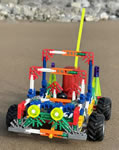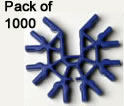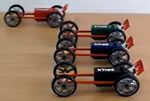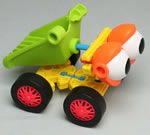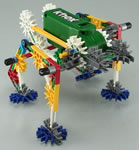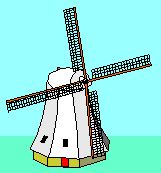
Windmill challenge
You have been stranded on a desert island in the middle of the Pacific ocean. The only plant growing on the island is fuji grass, a sort of wheat. Could you build a windmill, which can crush the wheat grains to make flour, so you can bake bread to eat? And could you also build a large hammer in the windmill, which goes up and down when the wind blows? You will need this to crush the straw left over from the wheat into strawboard, to make a raft to escape on.
Levels of difficulty:
Level 1 - Make a windmill, with sails that will go round and round when you turn a handle
Level 2 - As level 1, with a moving grindstone which turns above a fixed grindstone when the sails turn
Level 3 - As level 2, plus a hammer that goes up and down when the sails turn
Equipment: K’NEX set.
Approach: Why not start by making a 3-D frame for your windmill? Then you can make the sails, and think about how to attach them to the frame so that they turn easily. Now make a handle, which can turn the sails for you. If you are moving on to level 2, think about how you can change the vertical rotary motion of the sails into a horizontal rotary motion for the grindstones. Also, how can you make the sails turning up in the air turn a grindstone which is near the ground? For level 3, you will need to think about how the rotary motion in your windmill can be turned into an up-and-down (linear) motion for the hammer.
Handy Hints (please click to view):
A2 - 3 ways to connect K'NEX rods and connectors
A4 - Making corners with blue & purple connectors
W5 - Wheels and tyres
W6 - Making rods turn with wheels or connectors
W7 - Pulleys
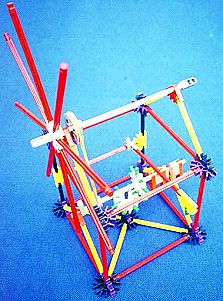
Teachers' Notes
A project to show that the force of a wind blowing in a straight line can be converted to rotary motion, and that pulleys, gears, cams and levers can be used to transfer that rotary motion.
Possible solution: See photo.
Before starting: Find examples of gears, levers, cams and pulleys. Look at some pictures of windmills, and find out why windmills were used. Then, if possible, look at a picture showing the internal workings of a windmill which was used to grind corn. Or, even better, visit a local working windmill (if you have one!).
Conclusion: Firstly, ask the children to draw a diagram of the windmill. This should include arrows to show how the wind blowing causes the sails to turn, and all other moving parts. Then (for levels 2 and 3) ask them to write underneath their diagram an explanation of how the force from the wind is transmitted through the moving parts to grind the corn and make the hammer move up and down.
Copyright © Andy Shercliff 1996 and K'NEX User Group 2004

